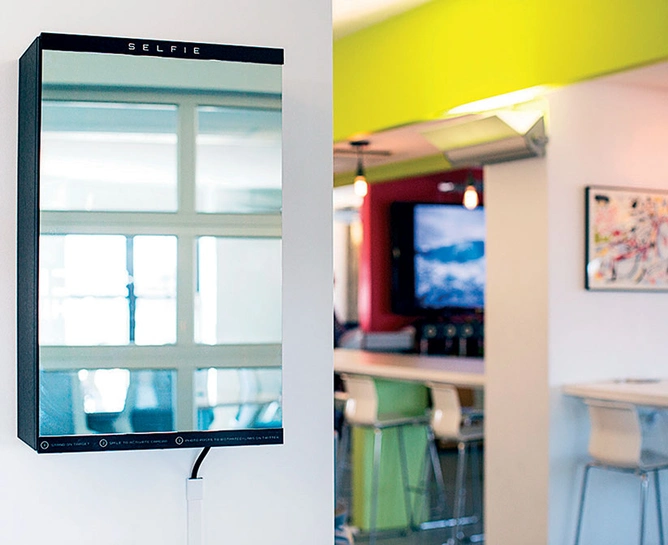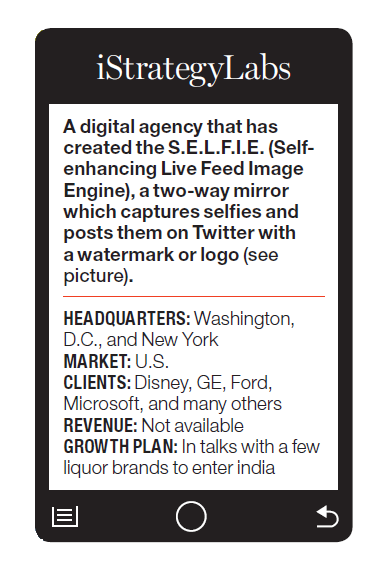BILL GATES is an addict, but Satya Nadella isn’t showing the same zeal for viral selfies just yet. Microsoft’s new boss is likely saving himself up for Superman. That’s the codename of the much-hyped ‘selfie-phone’ his company is sweating over, which will reportedly be its first big launch after the Nokia acquisition.
Nobody knows whether Superman’s powers (a 5 MP front camera) will help Microsoft-Nokia regain its mojo, but ignoring mobile’s rambunctious new fad isn’t an option. Selfie—or ‘self-portrait’, usually shot on one’s smartphone—first sprang up in the drunken rant of an Australian blogger in 2002. But the term caught fire as a social meme only in 2013, impressing the Oxford English Dictionary enough to anoint it ‘Word of the Year’. Puritans sniggered, accusing selfie-lovers of shallow self-obsession. The latter’s riposte: pinging the word in the killjoys’ faces 17,000% more than in 2012. Bangalore-based digital consultancy MindShift Interactive reports that selfie as a hashtag has grown 200% since January last year, thanks to the burgeoning culture of online sharing. That culture will, in fact, be central to Yahoo’s math that nearly 1 trillion photographs will be taken the world over this year.

The upshot: a gold rush, led by smartphone companies. While it waits for Superman, Nokia has introduced a voice guide in its Asha series to help users take the best selfies. HTC has lined up big investments to “own the selfie market”, which it estimates at 90% of all smartphone photos in some geographies. Huawei’s selfie-optimised Ascend G6 was buzzing at this year’s World Mobile Congress, and Samsung too has announced its first selfie-focussed phone, the Galaxy K Zoom.
India is a blue-chip market for these companies, with over 430 million people in the 15 to 34 age group—the selfie’s home constituency. It also has the world’s youngest online population, the second-largest user base for Facebook globally, and, according to web analytics site alexa.com, the largest in Asia (discounting Russia) for the Instagram site. Significantly, Facebook and Instagram have a combined haul of over 55% of the selfies floating on the Net.
As technology gets smarter and social media adoption expands, the selfie is mutating into new formats. Velfies, or video selfies, are already a rage on Vine, a Twitter-owned app that allows users to upload and share six-second video clips. Twitter bought Vine for a reported $30 million
(Rs 176.8 crore) in 2012, and it became the fastest growing mobile app the following year. Facebook’s reply was to introduce a 15-second video feature on Instagram, its own billion-dollar purchase from 2012. India should be critical to the battle—Alexa says it’s also twitter.com’s largest base after the U.S.
Although most of India is still on feature phones, network equipment maker Ericsson expects smartphone sales to explode by 2020, from 90 million to 520 million devices. Data consumption is keeping pace: Nokia Solutions and Networks says 3G use in India more than doubled in 2013 over the previous year, outstripping global growth.

There’s of course the problem of India’s vast rural population. Rais agrees that selfies are an urban phenomenon, “but with social media localising content and technology firms optimising tools for regional markets, growth is inevitable”. He adds another catalyst: politicians and celebrities with mass appeal. From @narendramodi to
@iamsrk, newsmakers have replaced the old-fashioned photo-op with selfies around big (or not-so-big) events.
That leaves only the gender gap to contend with. Analytics website SelfieCity says women under 40 take more selfies than men of the same age. But only 30% of India’s working women own a smartphone, according to Qualcomm.
WHAT STARTED as a yuppyish medium of self-expression is fast evolving as a business tool, and not just for smartphones and social networks. Brands across sectors, from liquor to health insurance, are piggybacking on selfies to create targeted marketing campaigns.
But Viral Oza, marketing director at Nokia India, a subsidiary of Microsoft Mobile Oy, says mindlessly jumping on to the bandwagon would be a waste. “Selfies are a highly engaging medium where the consumers themselves are able to be part of the message. But as with any trend, it is crucial to understand the target market.”
Sumanta Ganguly, vice president of digital engagement planning at Bangalore-based digital agency Experience Commerce, says the savviest brands are giving the selfie a spin that makes it more than just another display picture. He gives the example of his client Signature, the whisky label from United Spirits. The brand signed up celebrity lensman Atul Kasbekar to launch the Signature Selfies campaign during the Signature International Fashion Weekend last November. Extending its association with fashion, the campaign invited young people to showcase their “most stylish” selfies using a custom-built app, attracting over 40,000 downloads and 14,000 entries. The grand prize: a personal shoot with Kasbekar, who came on board because “the campaign was ahead of the curve”.

Luggage maker VIP Industries hired Bangalore- and Mumbai-based digital consultancy 22feet Tribal Worldwide to manage the #BackIsTheNewFront campaign on Facebook and Twitter for its Skybags brand, calling for ‘reverse selfies’—or selfies with the backs to the camera—with Skybags products as prizes. The gimmick fetched 13,000 entries in a week.
Vodafone has traditionally reserved the IPL for key campaigns like the iconic ZooZoos. This year it added selfies to the mix through the Vodafone Fan Army Contest. Subscribers submitted group selfies (a.k.a “ussies”) on a microsite, and the winners were given tickets to IPL matches.
Ronita Mitra, senior vice president, brand communications and insights, Vodafone India, says selfies vibe with its mission of helping subscribers “connect, reach out, and share their life with their loved ones”. That intimacy also drew Max Bupa Health Insurance to start the #FamilySelfie contest, placing not just an individual at the centre.
Of course, there’s no way of finding out if these campaigns are bringing in any real business. “When you run a TV campaign, you can’t put a number to conversions,” says Zafar Rais, CEO of MindShift Interactive. “It’s the same with social media, not just selfies.” Sudip Ghose, head of marketing at VIP Industries, is more sanguine. “Selfies are like editorial content that works three times better than advertorials. Brands can crowdsource selfies of their loyalists with their products, [though] it has to be done subtly.”
Ganguly of Experience Commerce feels shooting selfies with a product is “lame”. “I ask brands to stay away from selfies, unless they can clearly define the value to the consumer.”
That brings us to fatigue, the resident evil of social trends. Tech website BGR feels the craze may have peaked: “If even the President [Obama] has taken a selfie, there is little room left for [it] to grow.” To counter that, the selfie ecosystem is betting on an inbuilt antidote. Kasbekar calls it the “constant flattery” of the perfect pout.










Leave a Comment
Your email address will not be published. Required field are marked*